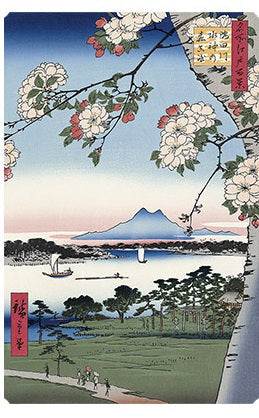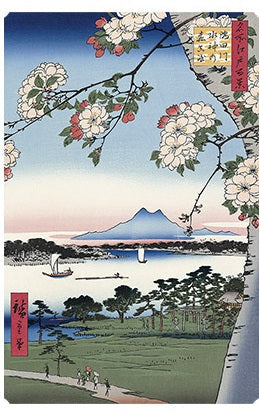アダチ版画研究所
Ukiyo-e Hiroshige Utagawa "Sumida river, grove of Suijin shrine and Masaki"
Ukiyo-e Hiroshige Utagawa "Sumida river, grove of Suijin shrine and Masaki"
Couldn't load pickup availability
The series "One Hundred Views of Famous Places of Edo" published late in the life of Hiroshige is celebrated as the final summary of his landscape prints. The series appears to have been published parcel after parcel as it won popularity, 37 designs in 1856, 71 in 1857, 10 in 1858, totaling 118 designs. The publisher was Uoei (Uo-ya Eikichi) at Shitaya Ueno Hirokoji.
This print reproduced here shows a compositional plan still more compound than any prints in this series. The artist's eyes have already been brought up to the top of a small hill. The cherry branches extending this way are shown large in close view, then travelers on the road and a shrine (perhaps Mimeguri) in pine grove in shallow bird's-eye view; the eyes are then raised again to see the stream of Sumida River and the distant view of Mt.Tsukuba in front-view level-distance method of observation. Such a composition as this has no similar example in the series, making it a unique piece.
The print bears the censor's seals "Tatsu (year of dragon) Eight" and "Aratame", revealing that it was published in the eighth month in the 3rd year of the Ansei era (1856). The censor's seal system came into being due to ban in the fifth month of Kansei 2nd year (1790) by the Bakufu (shogunate government) which prohibited doctrines other than that of Chintz school of Confucianism.
The Machibure Gokajo (Five Articles of Official Notice) concerning publication of books provided the basis for the system of Gyoji Aratame (censorship by representatives of publishers) enacted in the eleventh month of the same year, and the first meeting of Gyoji took place in the twelfth month.
The Machibure Gokajo in fact was not a new decree. It had earlier been stipulated in the twelfth month of Kyoho 7th year (1722) by the Machi-bugyo (city magistrate), Ooka Echizen-no-kami Tadasuke, as an ordinance concerning new publications, and had been neglected. It was now revived and strengthened with police authority.
Its main purpose was to oppress criticism against established social order. It became an annual custom at the general meeting of publishers in January to recite the Gokajo (Five Articles) to remind them of the stipulations.
In the field of ukiyo-e prints, the articles were applied for the reason of corruption of public morals. The times were so nervous that they were often applied even to landscapes. This trend, we might say, heightened popularity of clean, wholesome landscape prints like Hiroshige's.
| Screen dimensions | 38.0×25.5cm |
| Frame size | 55.5×40.0cm |

FAQ
I would like to combine multiple orders, is that possible?
Excuse us but please note that all products on this site are shipped directly from the producers, so we cannot bundle multiple ordered products.
When will the item be delivered?
As a general rule, we will ship within 7 business days after payment is confirmed. However, the shipping date may differ depending on the arrival status of the product.
*If we are unable to prepare the ordered product for reasons such as being out of stock, we will contact you by email and discuss the matter with you.
I would like a refund for this item.
Please request a return from the inquiry page of this site within 8 days after the product arrives, and promptly return the product to the location specified by the customer center. In addition, the shipping fee for returning the product will be borne by the customer. For details, please see "Specified Commercial Transaction Law".

